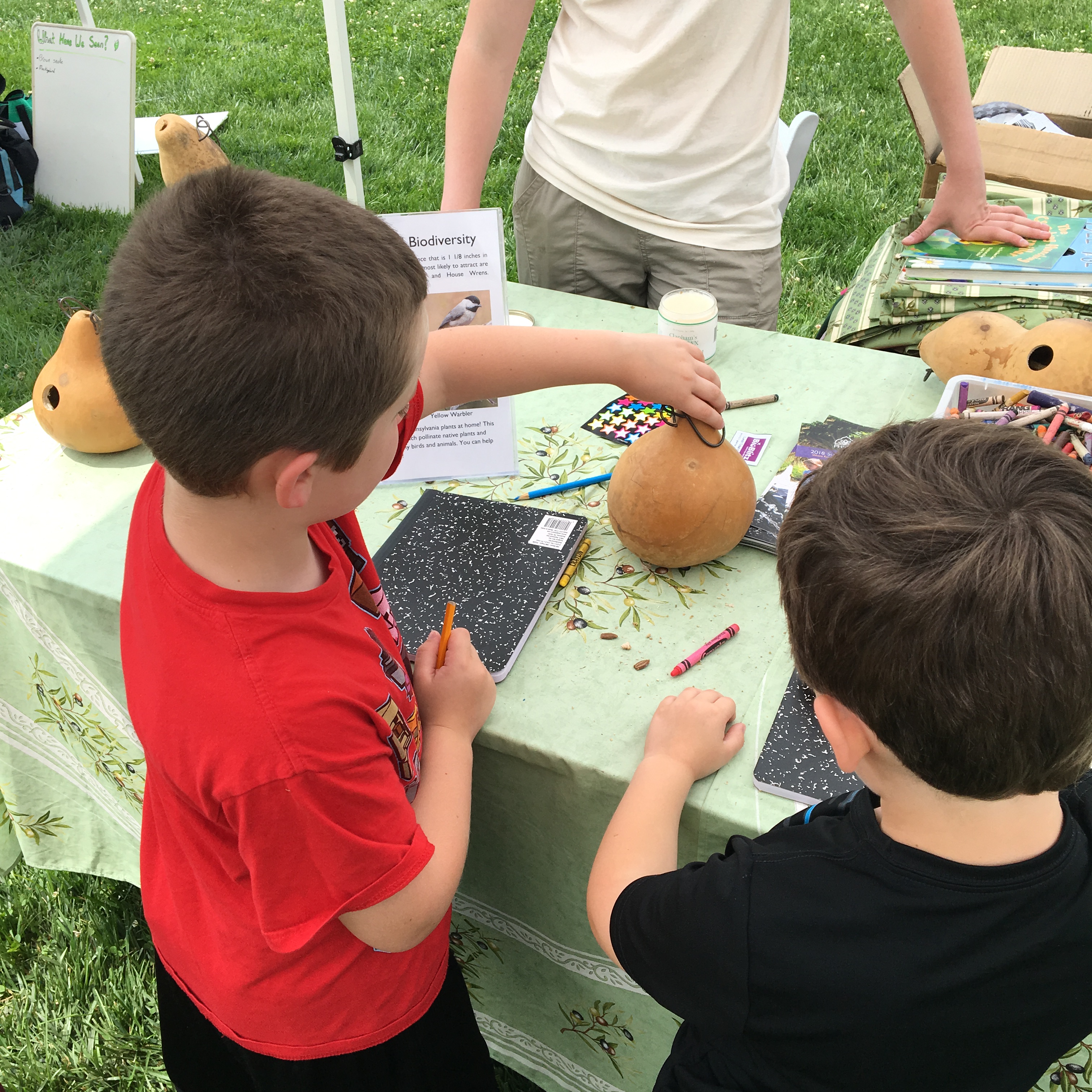Blog
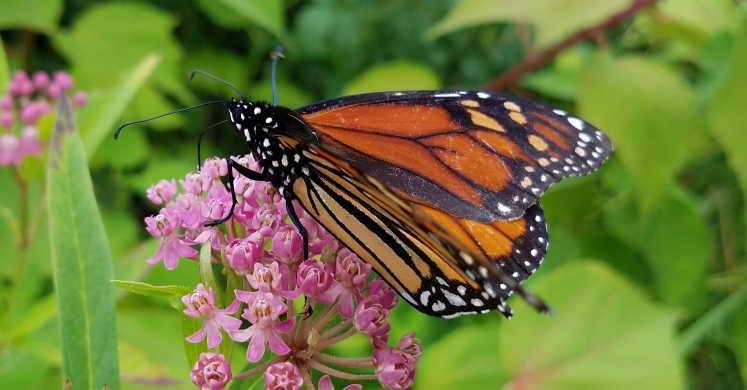
#bioPGH Blog: BioBlitz 2018 Results
 A resource of Biophilia: Pittsburgh, #bioPGH is a weekly blog and social media series that aims to encourage both children and adults to reconnect with nature and enjoy what each of our distinctive seasons has to offer.
A resource of Biophilia: Pittsburgh, #bioPGH is a weekly blog and social media series that aims to encourage both children and adults to reconnect with nature and enjoy what each of our distinctive seasons has to offer.
The early morning skies were gray, and rumbles of thunder echoed over the hills. Nevertheless, almost as though even weather itself knew it was an important day, the clouds cleared just in time and the sun shone on the full day of BioBlitz!
This past Sunday, June 10, was an adventure-packed day of science, guided nature tours into Schenley Park, exhibits and demonstrations from local naturalists, engaging activities from community organizations, and even nature-themed art projects and story time—it was truly a day for the whole family. The goal of the event, though, was to complete an inventory of the living things within Schenley Park, and local researchers identified 229 species of insects, birds, mammals, fish, plants, fungi, amphibians, and reptiles in areas surrounding Panther Hollow Lake and along Phipps Run and Panther Hollow Run!
If you missed out the fun, check some of the highlights below, and keep reading to explore the full species list from the BioBlitz. Thank you to everyone who was involved - your presence and dedication to nature was truly appreciated. And to all of us who love the outdoors, let’s keep exploring!
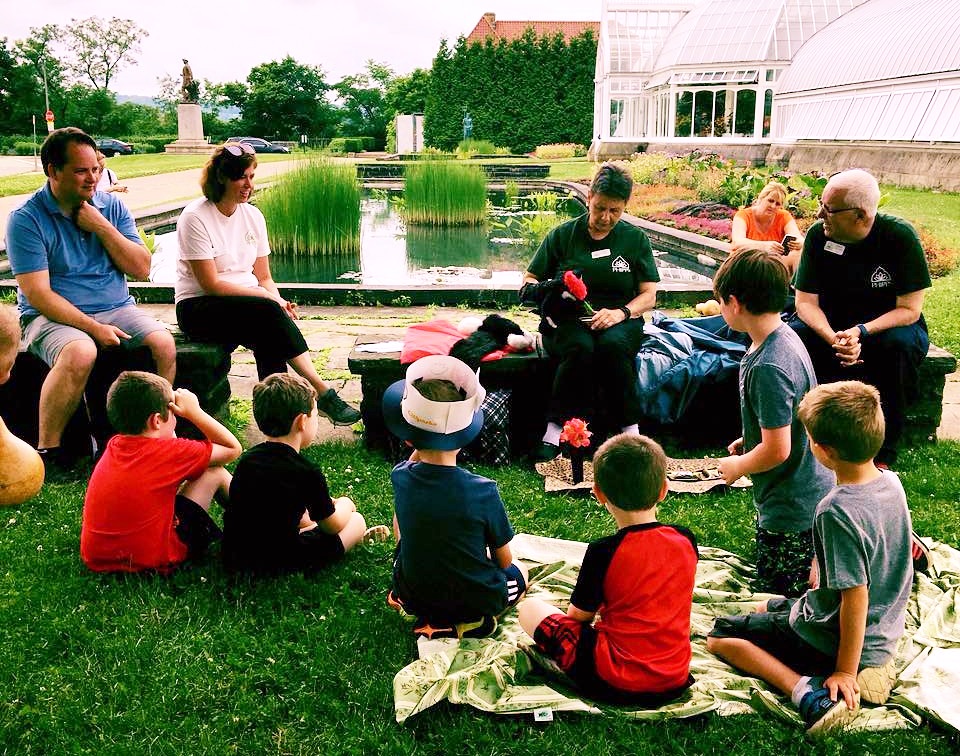
In the morning and afternoon, young naturalists could enjoy a nature-themed story time under the shade of a large tree on the front lawn. Here some budding scientists enjoy a story time led by Phipps docents Verna and Bernie McGinley. Photo credit Samantha Lee.
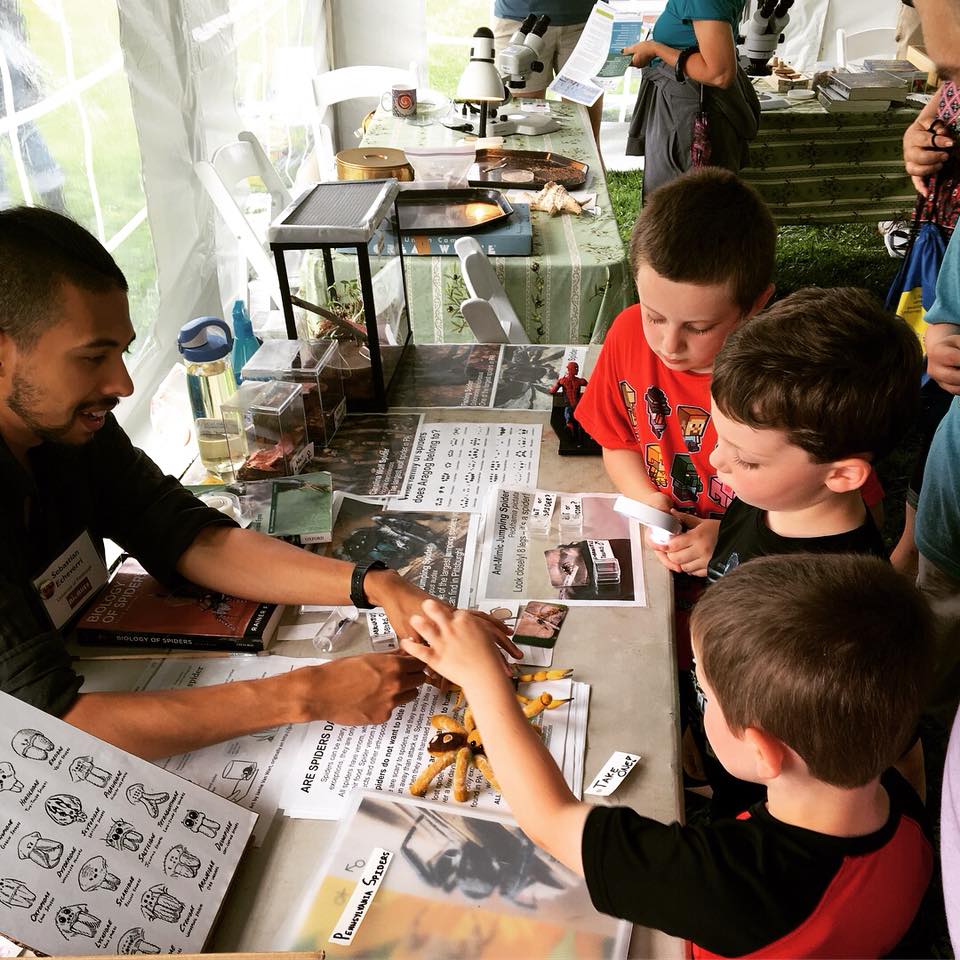
Children learn about spiders from University of Pittsburgh graduate student Sebastian Echeverri. Photo credit Samantha Lee.
Little naturalists decorate gourd birdhouses at one of Phipps’ activity stations. Photo credit Samantha Lee.
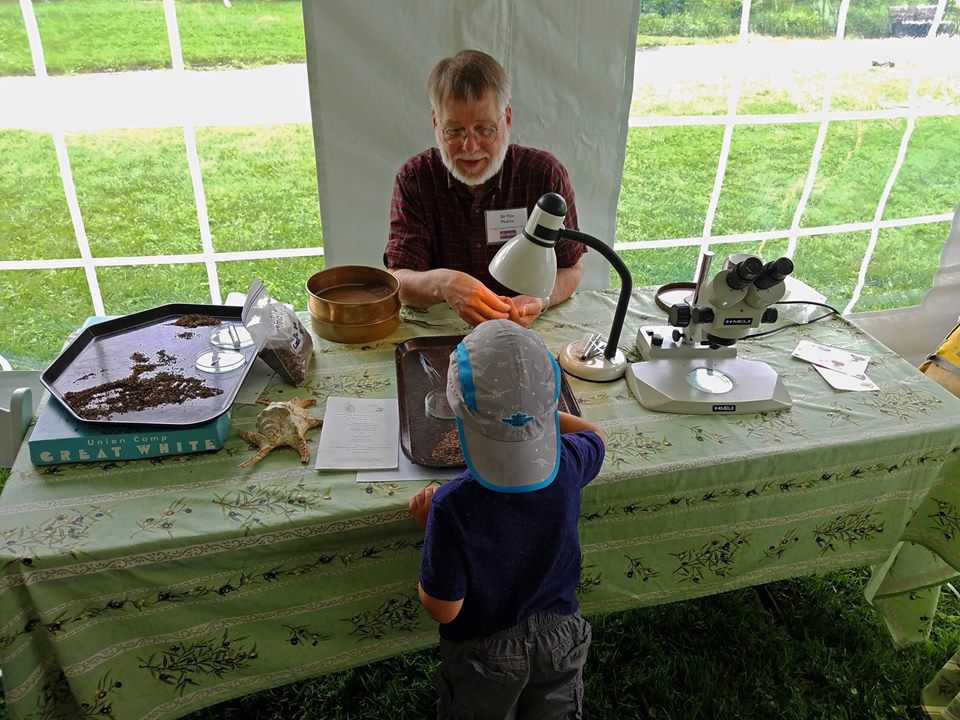
A future little malacologist (mollusk expert) learns about terrestrial snails from Dr. Tim Pearce, the curator of Mollusks at the Carnegie Museum of Natural History.
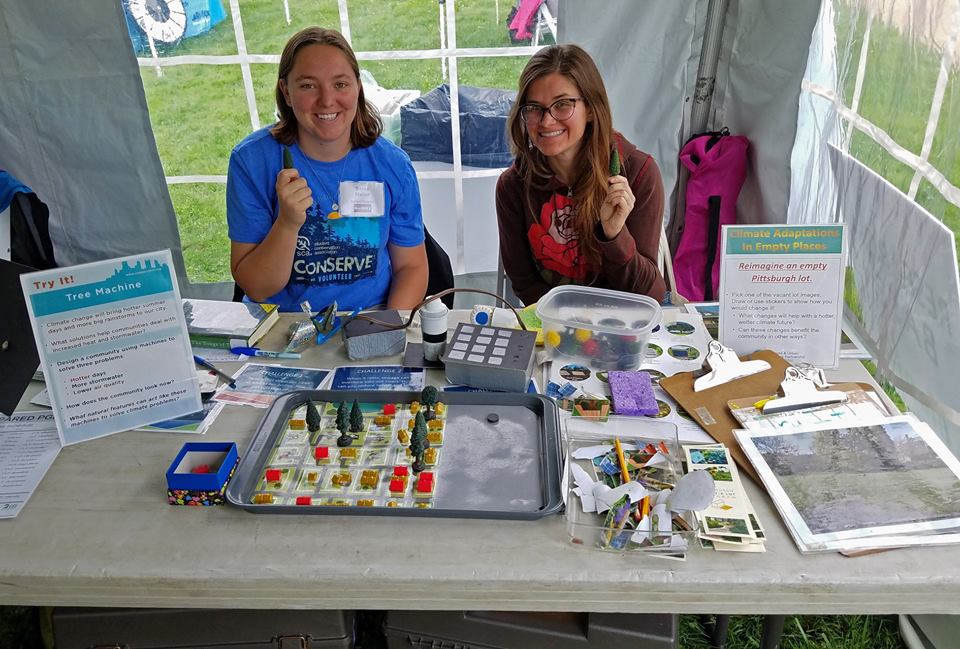
Becca Halter and Rebecca Kiernan of Resilient Pittsburgh showcase their sustainability activity.
Most importantly, the BioBlitz was an excellent day for science. This year, at least 229 unique species were identified. Below you can compare results of this year to our previous two BioBlitzes. One of the important facets of conducting this even every is to monitor any significant changes in biodiversity over time—which could indicate a problem in the ecosystem. (On that note, you may have noticed a distinct increase in the number of invertebrate species identified from 2016 and the other two years, but this is more likely the result of an increase in the number of experts participating in the event.) Also, be sure to check out our BioBlitz project on iNaturalist to see images of some of the identifications below.
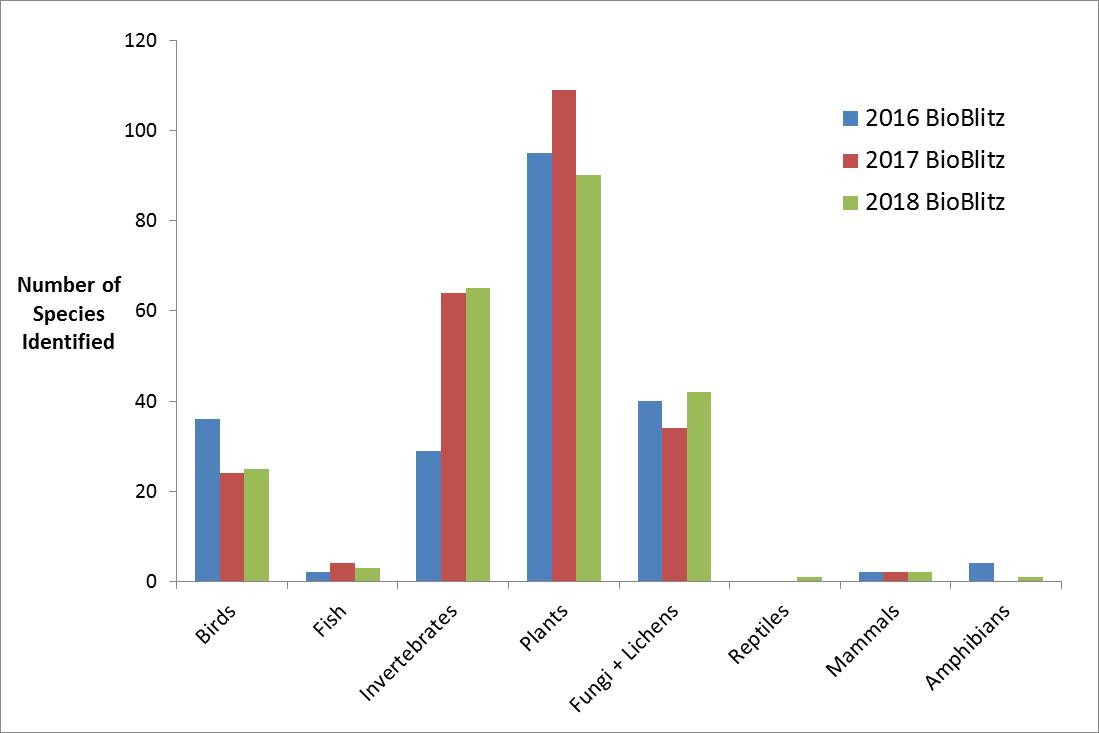
Total Identified Species at the 2018 BioBlitz
|
Birds, Common name |
Birds, Scientific name |
|
American Robin |
Turdus migratorius |
|
Yellow Warbler |
Setophaga petechia |
|
Redwing Blackbird |
Agelaius phoeniceus |
|
Song Sparrow |
Melospiza melodia |
|
Wood Thrush |
Hylocichla mustelina |
|
Blue Jay |
Cyanocitta cristata |
|
Northern cardinal |
Cardinalis cardinalis |
|
Oriole |
Icterus galbula |
|
Mallard |
Anas platyrhynchos |
|
Red-tailed hawk |
Buteo jamaicensis |
|
Chimney Swift |
Chaetura pelagica |
|
Ruby-throated hummingbird |
Archilochus colubris |
|
Northen Flicker |
Colaptes auratus |
|
Eastern Wood-Pewee |
Contopus virens |
|
Acadian Flycatcher |
Empidonax virescens |
|
Eastern Phoebe |
Sayornis phoebe |
|
Red-eyed Vireo |
Vireo olivaceus |
|
Northern Rough-winged swallow |
Stelgidopteryx serripennis |
|
Tufted Titmouse |
Baeolophus bicolor |
|
Gray Catbird |
Dumetella carolinensis |
|
European Starling |
Sturnus vulgaris |
|
Scarlet Tanager |
Piranga olivacea |
|
Brown-headed Cowbird |
Molothrus ater |
|
House Finch |
Haemorhous mexicanus |
|
American Goldfinch |
Spinus tristis |
|
Fish, Common name |
Fish, Scientific name |
|
Pumpkin seed |
Lepomis gibbosus |
|
Bluegill |
Lepomis machrochirus |
|
White crappie |
Pomoxis annularis |
|
Plants, Common Name |
Plants, Scientific name or taxonomic grouping |
|
Amaranth |
Amaranthus sp. |
|
American Beech |
Fagus grandifolia |
|
American elm |
Ulmus americana |
|
American sweetgum |
Liquidambar styraciflua |
|
Asiatic dayflower |
Commelina communis |
|
Basswood |
Tilia Americana |
|
Bigtooth aspen |
Populus grandidentata |
|
Black Locust |
Robinia pseudoacacia |
|
Black locust |
Robinea pseudoacacia |
|
Bladdernut |
Staphylea trifolia |
|
Bottlebrush Buckeye |
Aesculus parviflora |
|
Boxelder Maple |
Acer negundo |
|
Broadleaf cattail |
Typha latifolia |
|
Bur oak |
Quercus macrocarpa |
|
Bush honeysuckle |
Lonicera spp. |
|
Canada thistle |
Cirsium arvense |
|
Celandine |
Chelidonium majus |
|
Chestnut Oak |
Quercus montana |
|
Chicory |
Cichorium intybus |
|
Clearweed |
Pilea pumila |
|
Clover |
Trifolium sp. |
|
Cock's-foot |
Dactylis sp. |
|
Common blue violet |
Viola sororia |
|
Common dandelion |
Taraxacum officinale |
|
Common duckweed |
Lemna minor |
|
Common motherwort |
Leonurus cardiaca |
|
Creeping Buttercup |
Ranunculus repens |
|
Creeping Cinquefoil |
Potentilla reptans |
|
Crown vetch |
Securigera varia |
|
Curly dock |
Rumex crispus |
|
Deptford pink |
Dianthus armeria |
|
Duckweed sp. |
Araceae family |
|
Eastern red bud |
Cercis canadensis |
|
Elm sp. |
Ulmus spp. |
|
English Plantain |
Plantago lanceolata |
|
fleabane |
Erigeron sp. |
|
Fragrant sumac |
Rhus aromatica |
|
Garlic mustard |
Alliaria petiolata |
|
Golden alexanders |
Zizia aurea |
|
Ground Elderberry |
Aegopodium podagraria |
|
Hackberry |
Celtis occidentalis |
|
Hickory |
Carya spp. |
|
Honey locust |
Gleditsia tricanthos |
|
Hop hornbeam |
Ostrya virginiana |
|
Japanese knotweed |
Fallopia japonica |
|
Jewelweed |
Impatiens sp. |
|
Kentucky coffee tree |
Gymnocladus dioicus |
|
Linden tree |
Tilia sp. |
|
London Plane Tree |
Platanus × acerifolia |
|
Mayapple |
Podophyllum peltatum |
|
Milkweed |
Asclepias syriaca |
|
Moss |
Bryophyta |
|
Moth Mullein |
Verbascum blattaria |
|
Mugwort |
Artemisia vulgaris |
|
Northern Hackberry |
Celtis occidentalis |
|
Northern Red Oak |
Quercus rubra |
|
Norway maple |
Acer platanoides |
|
Ox eye daisy |
Leucanthemum vulgare |
|
Pennsylvania pellitory |
Parietaria pensylvanica |
|
Pennsylvania smartweed |
Polygonum pensylvanicum |
|
Philadelphia Fleabane |
Erigeron philadelphicus |
|
Poison Ivy |
Toxicodendron radicans |
|
Pokeweed |
Phytolacca americana |
|
Ragweed |
Ambrosia artemisiifolia |
|
Red clover |
Trifolium pratense |
|
Red dead nettle |
Lamium purpureum |
|
Red maple |
Acer rubrum |
|
Red mulberry |
Morus rubra |
|
Red oak |
Quercus rubra |
|
Red Osier Dogwood |
Cornus sericea |
|
Serviceberry |
Amelanchier arborea |
|
Staghorn sumac |
Rhus typhina |
|
Sugar maple |
Acer saccharum |
|
sulphur cinquefoil |
Potentilla recta |
|
Sycamore |
Platanus americana |
|
thistle species |
Asteraceae |
|
Tree of Heaven |
Ailanthus altissimia |
|
Tulip Poplar |
Liriodendron tulipifera |
|
Vine |
Parthenocissus sp. |
|
Virginia Creeper |
Parthenocissus quinquefolia |
|
White clover |
Trifolium repens |
|
White Oak |
Quercus alba |
|
White snakeroot |
Ageratina altissima |
|
Willow sp. |
Salix spp. |
|
Witch Hazel |
Hamamelis virginiana |
|
Wood nettle |
Laportea canadensis |
|
Woodsorrel |
Oxalis sp. |
|
Yarrow |
Achillea millefolium |
|
Yellow hop clover |
Trifolium campestre |
|
Yellow wingstem |
Verbesina alternifolia |
|
Mollusks, common name |
Mollusks, Scientific name |
|
Herald snail |
Carychium minimum |
|
Small spot snail |
Punctum minutissimum |
|
Black striate snail |
Striatura ferrea |
|
Iroquois Vallonia |
Vallonia excentrica |
|
Drapernaud's glass snail |
Oxychilus draparnaudi |
|
Ice thorn snail |
Carychium exile |
|
Pinhead spot snail |
Paralaoma servilis |
|
Globose dome |
Ventridens ligera |
|
Arthropods, Common name |
Arthropods, Scientific Name |
|
American house spider |
Parasteatoda tepidariorum |
|
Ant mimic sac spider |
Castianeira longipalpa |
|
Asiatic Wall jumping spider |
Sitticus fasciger |
|
Bumblebee |
Bombus sp. |
|
Bumblebee |
Bombus impatiens |
|
Cabbage white butterfly |
Pieris rapae |
|
Carpenter ant |
Camponotus sp. |
|
Centipede |
Scolopendromorpha |
|
Chloropidae fly |
Chloropidae |
|
Clubonid spider |
Clubionidae sp. |
|
Common water strider |
Aquarius remigis |
|
Common white tail dragonfly |
Libellulidae |
|
Cross orb weaver |
Araneus diadematus |
|
Dragonfly |
Aeschnidae |
|
dragonfly |
Gomphidae |
|
Eastern bumblebee |
Bombus impatiens |
|
Ebony jewel wing damselfly |
Calopteryx maculata |
|
Elm sack gall aphid |
Tetraneura ulmi |
|
Flea jumping spider |
Naphryes pulex |
|
Fungus gnat |
Cecidomyiidae |
|
Gnat |
Chironomidae |
|
Golden jumping spider |
Paraphidippus aurantius |
|
Grass fly |
Dolichopodidae |
|
Green bottle fly |
Calliphoridae |
|
Hackberry emperor |
Asterocampa celtis |
|
Harvestman / "Daddy long legs" |
Leiobunum ventricosum |
|
Harvestman / "Daddy long legs" |
Leiobunum verrucosum |
|
Leafcutting bee |
Megachilidae sp. |
|
Long jawed orb weaver |
Tetragnatha sp. |
|
Margined calligrapher |
Toxomerus marginatus |
|
Margined leatherwing |
Chauliognathus marginatus |
|
Milkweed bug |
Oncopeltus fasciatus |
|
Millipede |
Diplpoda |
|
Millipede |
Pseudopolydesmus sp |
|
Orb weaver |
Araenus sp. |
|
Orb weaver |
Agriope sp. |
|
Orchard spider |
Leucauge venusta |
|
Pearl crescent butterfly |
Phyciodes tharos |
|
Poplar petiole gall aphid |
Pemphigus populitransversus |
|
Pure green augochlora |
Auguchlora pura |
|
Red velvet mite |
Trombidiidae |
|
Sac spider |
Chira conthium sp. |
|
Sarcophagidae fly |
Oestroidea |
|
Sowbug |
Isopoda |
|
Spirea aphid |
Aphis spiraecola |
|
Spittle bug/froghopper |
Cercopoidea |
|
Summer azure |
Celastrina neglecta |
|
Sweat bee |
Halictidae |
|
Sylanvana jumping spider |
Colonus sylvanus |
|
Syrphid Flies |
Syrphidae sp. |
|
Unknown green orb spider |
Thomisidae sp. |
|
Unknown juvenile crab spider |
Thomisidae sp. |
|
Wasp |
Vespa sp. |
|
Wedge-shaped beetle |
Ripiphoridae |
|
Western honey bee |
Apis mellifera |
|
White faced jumping spider |
Hentzia mitrata |
|
Zebra jumping spider |
Salticus scenicus |
|
Fungi and Lichens |
|
|
Amanita amerirubescens |
|
|
Amanita cokeri (Coker’s Amanita) |
|
|
Amanita flavoconia (Yellow Patches) |
|
|
Amanita minutula |
|
|
Bjerkandera adusta (Smoky Polypore) |
|
|
Boletus subvelutipes (Red-Mouth Bolete) |
|
|
Candelaria concolor (Candleflame lichen) |
|
|
Ceratiomyxa fruticulosa (Coral Slime) |
|
|
Crucibulum laeve (White-egg Bird’s-nest Fungus) |
|
|
Cyathus striatus (Splash Cups) |
|
|
Datronia mollis |
|
|
Exidia recisa (Brown jelly roll) |
|
|
Ganoderma applanatum (Artist’s Conk) |
|
|
Gloeoporus dichrous |
|
|
Hypomyces hyalinus (Amanita Mold) |
|
|
Inocybe rimosa (Straw-colored Fiber-head) |
|
|
Inocybe unicolor |
|
|
Lactarius quietus var. incanus |
|
|
Laetiporus sulphureus (Chicken Mushroom; Sulphur Shelf) |
|
|
Leucogloea compressa |
|
|
Lycogala epidendrum (Wolf’s Milk Slime) |
|
|
Marasmius pulcherripes |
|
|
Marasmius rotula (Pinwheel Marasmius) |
|
|
Panaeolus foenisecii (The Lawn Mowers Mushroom) |
|
|
Panus conchatus |
|
|
Parmelia sp (Shield lichens) |
|
|
Phellinus robiniae |
|
|
Pleurocybella porrigens (Angel-wing Mushroom) |
|
|
Polyporus elegans (Elegant Polypore) |
|
|
Psathyrella candolleana |
|
|
Resupinatus applicatus (Black Jelly Oyster) |
|
|
Russula mariae (Purple-bloom Russula) |
|
|
Russula tenuiceps |
|
|
Russula vinacea |
|
|
Ruzenia spermoides |
|
|
Schizophyllum commune (Split Gill) |
|
|
Scutellinia scutellata (Reddish Eyelash Cup) |
|
|
Stereum complicatum (Crowded Parchment) |
|
|
Stereum ostrea (False Turkey-tail) |
|
|
Trametes versicolor (Turkey-tail) |
|
|
Tylopilus ferrugineus |
|
|
Xylaria vasconica (prev. known as Xylaria polymorpha) |
|
|
Amphibians, Common name |
Amphibans, Scientific name |
|
Green frog |
Lithobates clamitans |
|
Reptiles, Common name |
Reptiles, Scientific name |
|
DeKay's brown snake |
Storeria dekayi |
|
Mammals, Common name |
Mammal, Scientific name |
|
Eastern chipmunk |
Tamias striatus |
|
Eastern Gray Squirrel |
Sciurus carolinensis |
Phipps Research and Science Education department would like to thank all of the scientists and researchers who made the BioBlitz possible. Thank you to Dr. Brady Porter, Dr. Sarah Woodley, Dr. Kyle Selcer, Jennifer Broderick and Sara McClelland of Duquesne University; Dr. Tim Pearce of the Carnegie Museum of Natural History; Sebastian Echeverri of the University of Pittsburgh; the Western Pennsylvania Mushroom Club; Dr. Ryan Gott of Phipps Conservatory; Christian Neumann of Apoidea; Resilient Pittsburgh; the Pittsburgh Parks Conservancy; the Allegheny Land Trust; the Citizen Science Club; PennFuture; the Girl Scouts of Western Pennsylvania; Commonwealth Charter Academy; Hope Grows; GASP; BikePGH; and all of the volunteers and docents who lent their time.
